#pmmm meta
Text

Smile!
In Magia Record's re-run of the Nagisa's Wish event, Yuu has at long last been given a canon design, and she's adorable.
In the past, I drew a design for her myself (here, and here) based on the old silhouette they used and I talked a bit then about the similarities I saw between her and Nagisa's appearances. Have a look at those for context if you'd like, because I'm going to revisit that again here with her new look. Below the cut ↓
To start with, some of the things I pointed out on Yuu's silhouette as being shared with Nagisa's magical girl outfit did not survive to her final appearance, such as the fuzz around the edge of her neck frill, the shorts she wears, and the bows along her tails and across her frill.
Though the tails themselves which I compared to the pompoms hanging from Nagisa's hat did survive, that alone isn't enough to draw a connection.

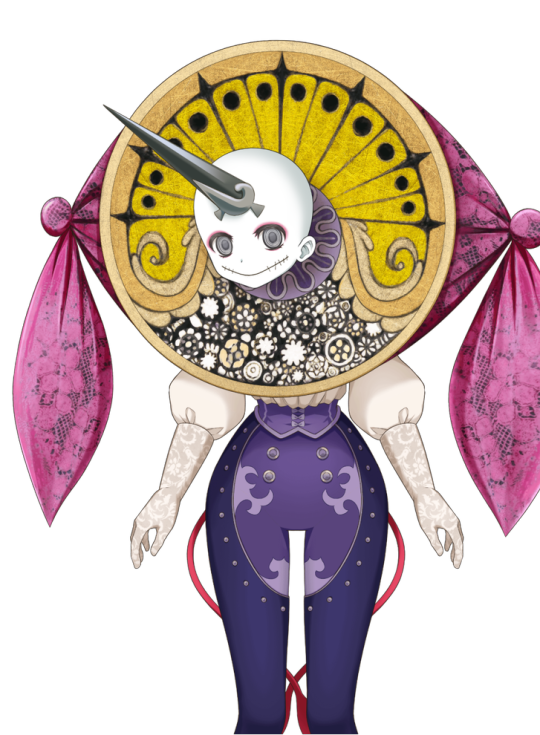
So it seems unlikely that when Nagisa made her wish, her appearance was influenced by Yuu being the first and only magical girl she'd met up to that point.
We can scrap that idea.
However, the parts of Yuu that I noted as resembling Nagisa's witch form, Charlotte... those do still hold up. When you look closely at Yuu, she has rings in her eyes which aren't present when she isn't transformed, and we now know that she uses her horn as her weapon.
Charlotte has a pure white face and a split open mouth, like Nagisa's mother described her killer. This is the strongest piece of evidence which the rest of it is built upon.
Charlotte attacks with her face as well.
And admittedly, perhaps reaching a little here, Charlotte as a worm has a cone-shaped pointy nose that might resemble Yuu's horn.
They also just both have clown energy.

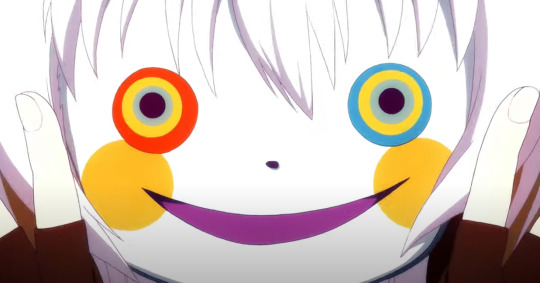
Huh. Looking at these pictures I'm now wondering if I could draw a comparison between Charlotte's head wings and the bundles of cloth hanging from either side of Yuu's head.
...
Yuu was instrumental in Nagisa's transformation over the course of the story, from someone accepting of the abuse she experienced every day into a person seeking to cut ties with her family and create her own freedom, and then Yuu played the part of the person who mistakenly took Nagisa's agency away from her at the end which is what tipped Nagisa over the edge, so I like the idea a lot that Nagisa's grief made manifest from that event took a form that recognises the significance of the Sleepwalking Ghost.

#pmmm#puella magi madoka magica#mahou shoujo madoka magika#magireco#magia record#yusa yumeno#yumeno yusa#yuusa yumeno#yumeno yuusa#nagisa momoe#momoe nagisa#pmmm meta#art#fan art#my art
86 notes
·
View notes
Text

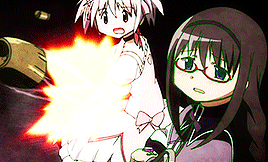

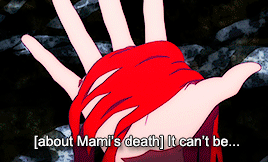


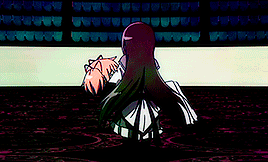
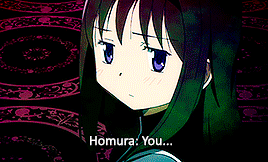
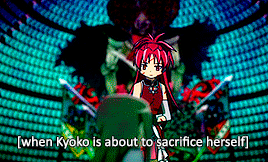

Homura + caring about the other magical girls
479 notes
·
View notes
Text
color symbolism in madoka magica
Obviously colors are important in PMMM, each soul gem is assigned to each girl based on a color, and the girls have very prominent color schemes, but why each color scheme for each girl? And does it go any deeper than that? I am going to pick it apart one color at a time going in rainbow order, first by analyzing what each color means to each magical girl and their wish, and then applying that to where else the color can be found in the series. (this is my first meta post pls be nice to me)
RED - PASSION
Red is Kyoko’s signature color, representing her passionate and abrasive nature. Her association with red represents her attitude and fiery energy, as well as her wish. Her wish was for people to respect her father, and listen to his teachings and passions. She’s a veteran, and a very powerful magical girl.
In addition to Kyoko, Kyubey has disturbingly red eyes because it’s super creepy, but also because he’s a very powerful figure in the show. Only his eyes are red, representing power and a strong will to achieve a goal, but not a true passion.
At the very beginning of the series, there is a scene with Madoka and her mother about choosing which hair tie. Her choice is between a yellow one and a red one, and ultimately Madoka chooses the red one, encouraged by her mother. Madoka’s mother is also associated with the color red, being a powerful businesswoman and role model.
In Madoka and Homura’s scene together in between worlds, Madoka gives Homura her red hair tie. Homura keeps the hair tie and wears it in honor of Madoka’s sacrifice in the new reality. Homura, now having the hair tie, adds a red element to her purple and black color scheme that was not present before. Madoka, on the other hand, loses all red in her color scheme. The hair tie serves to ask the question: did Madoka really choose her passion? Madoka wanted to live, we see that frequently in the series. She hesitates to become a magical girl all throughout the series because of this desire to live. She wants a normal life, but she puts the well being of others over her own. That being said, her desire to help others does not erase her desire to live. In a perfect world she would be able to do both, but instead, she passes the baton (or more literally the hair tie) to Homura, who only ever wanted to save Madoka from her cruel fate. Homura then gets to live her life free of becoming a witch. Power, true power, is in living your life the way that you want to. Kyoko lives her life the way she wants. Madoka’s mother lives her life the way she wants. But not Madoka, who gives up her red hair tie in hopes that Homura can live her life the way she wants.
Rebellion takes Homura’s desires to the absolute extreme, and the color red is not absent in showing it. Homulily dons red spider lilies, and Homura wears the red hair tie all throughout Rebellion, except for the very end when she gives it back to Madoka. When Homura has the hair tie, she follows her passion, which is to save Madoka and give her a normal life. At the end of the movie she accomplishes this goal, and gives the hair tie back to Madoka. Homura gives up her chance at a normal life so Madoka can have one. Akuma Homura also has plenty of red in her color scheme, further enunciating that Homura’s devil form is the epitome of her desire to give Madoka everything she deserves.
ORANGE - ACCEPTANCE
Okay red was a long one I promise they’re not all this long this color is a lot less complex. Orange is Nagisa’s soul gem color, and most likely represents acceptance, but I’d love to hear someone else’s ideas on what orange might represent. Nagisa’s wish was to finally do something to impress her mother and to be loved by her. However, after her mother’s death she accepts that her mother treated her horribly, and instead seeks acceptance in other people and eventually finds it in Mami Tomoe.
YELLOW - SELF SACRIFICE
Yellow is Mami Tomoe’s soul gem color. Mami, as her name suggests, is a very maternal figure in the show specifically for Nagisa, Sayaka and Madoka. She protects them, advises them, and cares for them. The color yellow represents self sacrifice. Mami puts herself in harm’s way and ultimately perishes for it in order to show Sayaka and Madoka the gruesome nature of being a magical girl. This is in stark contrast to her own wish, which was to save herself. Her guilt over this wish drives her selflessness. She couldn’t save her family, but she can save others.
Madoka’s eyes turn yellow in her goddess form because she has made the ultimate self sacrifice for the fate of all magical girls. In the very beginning of the series, Madoka is encouraged by her mother to wear the red hair tie over the yellow one. Her mother opposes her decision to sacrifice herself, just as she opposed the yellow hair tie. At the very end of Rebellion, Madoka arrives at the school wearing the yellow hair tie, representing her past self sacrifice. As discussed earlier, Homura switches out her hair ties, replacing her self sacrifice with the desire and passion to live the way she wants. Madoka does not want to die, she wants to live the way she wants to, but ultimately when given the choice she will always choose to save others over herself. Without the influence of others, Madoka will choose to sacrifice herself. She will choose the yellow hair tie even if she doesn’t want to.
It’s worth mentioning that in color theory, yellow is the opposite of purple. I’ll get to purple later but it’s interesting that Homura’s signature color, which represents love, is the opposition to self sacrifice.
GREEN - NORMALCY/THE REST OF THE WORLD
Green is Hitomi’s color, and it represents normalcy. Green is the rest of the world outside of the magical girls. Green is the color of nature, and nature opposes magic.
BLUE - REGRET
Sayaka Miki’s signature color is blue, and it represents regret and sadness. Different from the despair represented by the color black, blue represents sadness as a natural part of life. Regret is inevitable, everyone makes bad decisions, but ultimately the goal is to not fall into despair and lose control of your life because of it. (Sayaka actually comments on this in Rebellion while fighting Hitomi’s nightmare!)
PURPLE - LOVE
Homura Akemi’s signature color is purple, representing love. Homura’s wish is based on her love for Madoka, and everything she does is for Madoka’s benefit. In Rebellion, in the flower scene, the flowers turn purple as Homura tells Madoka how important she is to her. Purple represents her original wish, while black represents what she becomes, which I will explore later.
PINK - HOPE
Madoka Kaname’s signature color is pink, representing hope. Madoka becomes the manifestation of hope, in contrast to despair. I forgot where I read this but in the original timeline Madoka uses her wish to save a cat. To save someone else is to hope that they will be okay. Madoka has hope for everyone around her, almost to a fault.
Pink is also a secondary color on Kyubey, representing the false sense of hope he gives to magical girls.
BLACK/WHITE - CONTROL
Black and white are interconnected in their symbolism so I’ll group them together. White is Kyubey’s color, while black is the color of grief seeds and witches. Black represents despair over a lack of control, while white represents overwhelming control. Witches are magical girls who have succumbed to despair, and the blackness that clouds a soul gem represents this despair. Magical girls have no control over this destiny, and often when finding out about this fate they succumb to despair anyway. White is both Kyubey and Goddess Madoka’s color, and it can also be found on each of the color schemes of every magical girl. It represents the control that Kyubey has on each of their lives. Madoka as a goddess replaces Kyubey as the controller of the fate of all magical girls, with a primarily white color scheme.
The reason I grouped these two together is because of Homura. While Homura’s soul gem color is purple, her color scheme differs from the rest of the magical girls in that it doesn’t contain much of her soul gem color. She wears a black and white outfit, representing her control over time, and her lack of control over Madoka’s fate. Homura is in a constant struggle of how much control she is allowed to have over her and Madoka’s lives. She’s controlled by Kyubey and knows it, and she knows of her eventual fate. As Akuma Homura, the white in her color scheme is completely gone. She has accepted her lack of control over her own fate. She knows that eventually Madoka will realize her fate and they will inevitably be enemies because of Madoka’s overwhelming need to sacrifice herself for others. She accepts the fact that she cannot control Madoka’s fate, but the least she can do is attempt to give her a normal life for a little while. She is free from Kyubey’s control, but has also lost all control over herself and her desires. Homura acts only on her wants, while Madoka does not act on her wants at all. This push and pull dynamic is represented through the colors black and white.
#pmmm#puella magi madoka magica#madoka magica#madoka kaname#homura akemi#kyoko sakura#mami tomoe#nagisa momoe#sayaka miki#pmmm meta
223 notes
·
View notes
Text
Rorschach Inkblots in Rebellion

When Sayaka confronts Homura at the end of Rebellion, a series of abstract images--five in all--flash across the screen as Homura explains herself. These are reminiscent of the famous Rorschach inkblots, a series of drawings used as a projective test by twentieth-century psychologists. Given all of the other references in the film to German literature, philosophy, psychoanalysis--from Freud's "Fort/Da!" to Nietzche's "Gott ist Tot!" and Eternal Recurrence" to Goethe's "Eternal Feminine", and the entirety of E.T.A. Hoffmann's The Nutcracker and the Mouse King--it's not surprising that Rebellion would go here, as the Rorschach test was a popular method of measuring the unconscious mind in psychoanalysis and thus fits perfectly with the film's established themes.
However, when I looked a little closer, I noticed that the cards in the film don't match any of the original ten cards in the system (i.e., the ones most commonly associated with the test).


Card #7 (left) and Card #9 (right) of the main Rorschach series, from Wikipedia.
As you can see from the sample above, the original ten Rorschach cards are either all black and white or all colored, but not both, unlike the "hybrid" cards in Rebellion. Why is that? And what do they mean?

I did some more digging, and it turns out that although it's fallen out of fashion in the United States since its peak in the 1960s, the Rorschach test is extremely popular in Japan, where it's used for everything from personality analysis to marriage counseling. In addition to the modified Rorschach systems created by Western psychologists like Samuel Beck and Bruno Klopfer, there are a number of uniquely Japanese systems, including the Karo Inkblot test by Yasufumi Kataguchi, so it's possible that these images in Rebellion are part of one of these systems.
However, because the whole point of these inkblot tests is that the subject's reaction should be spontaneous, the cards in these systems are generally not released/revealed publicly, making it difficult to prove their origins way or the other. So what then?
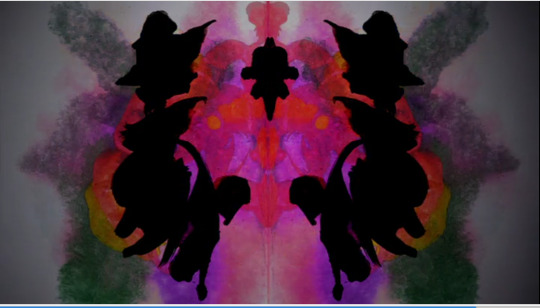
Ironically, that brings us right back around to projection! Since we the audience have no way of knowing what these images are supposed to mean, we have to construct the meaning out of these abstractions for ourselves, just like a real Rorschach test--which says as much about who we are and what we value as the image itself.

But let us not forget the greater context. As these images flash across the screen, they are accompanied by Homura's voiceover, declaring, (in the official English translation), "I am now an existence known as 'Evil'". Coupled with the abstract images, it suggests a certain level of moral ambiguity--is Homura truly evil or is this a role she has adopted in order to achieve her goals?

In a projective test, there are no right or wrong answers, only the limits of our imaginations and circumstances--paralleling the work of literary analysis and criticism. The genius of Rebellion is that, like the Rorschach test itself, the film provides no definitive answers to many of the questions that it raises, leaving the audience to decide how to interpret them--and even goes to the trouble of providing us these visual cues in order to emphasize the point.
49 notes
·
View notes
Text
among the holy quintet, mami stands out for a number of reasons: she is the first to die, and unlike sayaka and kyoko, she dies alone; she is the only member with neither a reciprocal romantic dynamic with another character nor a direct foil; she is also the only character who didn't use her wish to save or help another person, and she is the only one who became a magical girl without having a choice. in this way, her feelings of "isolation" are not just a trait of her character within the context of the story, but are habitually reinforced by the structure of the story itself. she is isolated both within the plot (at school, among other magical girls, etc) and metatextually, and this isolation is the root of her mental instability.
#chatter#puella magi madoka magica#pmmm meta#i've just been thinking about this a lot lol. mami is such an interesting character and she does not get enough credit for this
363 notes
·
View notes
Text
hot take: homura isnt evil nor a yandere and describing her as such is a disgrace to how multifaceted her entire character is and only works to further misunderstand her intentions and ignore the true nature of a lonely 14 year old lesbian's desperate wish . send tweet
#vio.txt#puella magi madoka magica#pmmm#pmmm meta#akemi homura#im just so sick of seeing this opinion everywhere like OF COURSE SHES GOING TO TAKE DRASTIC MEASURES FOR HER WISH...#madoka is her everything her babygirl her bestie forever like tell me you wouldnt become unhinged after that many failed time loops...#homura haters dni yall r ridiculous
136 notes
·
View notes
Text
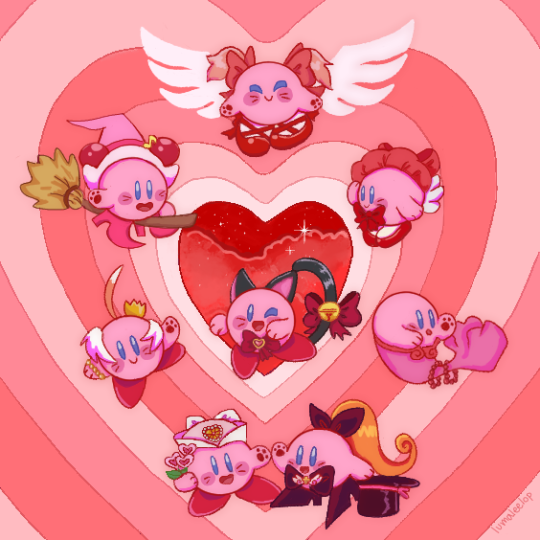
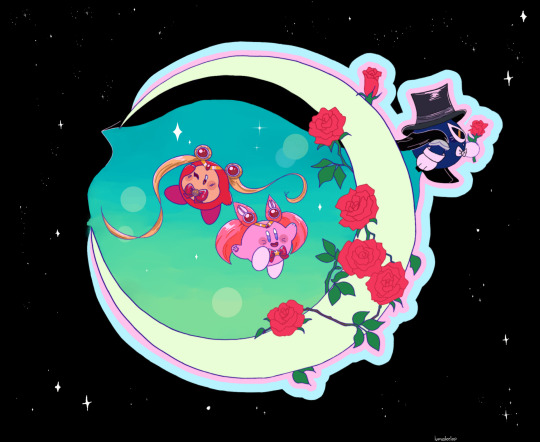
Kirby has all the qualifications to be a mahou shoujo protagonist!
#kirby#meta knight#sailor dee#sailor moon#pmmm#madoka magica#puella magi madoka magica#card captor sakura#tokyo mew mew#ojamajo doremi#princess tutu#mermaid melody#mermaid melody pichi pichi pitch#nurse angel ririka#nurse angel ririka sos#saint tail#mahou shoujos#magical girls#nintendo#nintendo fanart
591 notes
·
View notes
Text
reminder that homura is a middle schooler. she is 13 or 14 years old, depending on source. she is not old enough to drive or have a permit. she is not old enough to live on her own (it's implied her parents are out of the picture in some way — in the US she'd need to be in adoptive or foster care, or at least have a guardian or social worker, but this appears to be handwaved in the series and none are ever shown). she cannot vote. she is not old enough to get a job (earliest i've seen is 14 in the US, and that's usually in not great environments, in summer, and for low pay and short hours). she is only "independent" in the sense that it's forced upon her by lack of any adult support — nobody helps her fill out school transfer forms, she lives alone, she has no shown family or even mentions of relatives, nobody visits her in the hospital, etc.
i say this because a lot of "anti homura" arguments act as if this information doesn't exist, and that homura is "actually an adult" or at the same level as one due to looping. she canonically is not. her brain and physical body are not developing, she is only learning walpurgis tactics and memorizing test answers. her brain is not developing so she's not "mentally 26", like is often claimed by "homura is a predator" truthers. i'm not even going to touch on how weird and borderline creepy it is to say "she's a child but so mature for her age (from extreme, repeated, potentially pre-series trauma), so she must be an adult and can be treated like one".
there is a reason that children are typically tried differently in the US. unless "tried as an adult" for very serious crimes, it is widely accepted that children (and even young adults) are more impulsive, think less rationally, and are generally "less responsible" for their actions due to not having the experiences of a full grown adult. children are less mature, more prone to "overreaction" and panic, and are immature — because they are kids.
homura is a child. she also has extreme trauma, potentially from before the series even began (where are her parents? are they just neglectful? dead? why isn't there even a single adult helping her?) that is never helped or addressed. homura doesn't get help for any issues she has (obvious ptsd and depression, borderline delusions over the past being "just a dream" in wraith arc). she is not some spoiled, rich, mentally stable almost-adult who's never faced a consequence. she is a young and traumatized teenager, young enough to be a middle schooler, and has experienced:
neglectful, absent, missing, or dead family/parents
watching her friends die horrifically almost a hundred times
having zero adult support at all, no caseworker or help
bullying, half being because she's disabled
having her soul ripped from her body without consent and learning if she ever loses her soul gem (or god forbid accidentally drops it somewhere), her body will basically be "dead"
learning she and all her friends turn into eldritch horrors when they die, a process shown in rebellion to be something they are aware for (aka the horror that witches aren't "just" bodies being moved, they are actively and constantly suffering and aware to some degree the whole time)
learning that the witches they fight are girls around their age who fell into despair, and not purposeless monsters
learned of the prospect that witches can potentially "regrow" via familiars, thus if their consciousness transfers, this shows the possibility of literally eternal suffering as the witch is "reborn"
realization that, the more she tries to save madoka, the worse the situation gets
having a full on breakdown with delusions in wraith arc, thinking maybe madoka was all just a hallucination or a dream she had
finding out in rebellion it wasn't a dream, but then thinking she betrayed madoka by not stopping her from contracting
becoming a witch whose whole theme is based around suicide and wanting and waiting to die, but not being able to
being a witch whose familiars are malicious towards her and belittle her
trying to "fix" her believed betrayal of madoka by making a new world, ending up hated by sayaka and isolated from her friends
is still stuck as a witch while the last event happens!!! (her soul gem is never shown purified)
all of this while she is 13-14.
homura is not some cruel adult playing god because she is bored and likes the power trip and wants the world to burn. she is a deeply traumatized and mentally ill child who never got help. she is not a predator — and i honestly don't know if that is more of a "she's a predator because she's the most openly sapphic" or "she's a predator because she's traumatized and thus 'acts weird' due to trauma" belief nowadays in most anti-homura spaces, i've seen both. she is not a murderer or rapist or whatever else i've seen (yes, "homura is a sexual predator" claims exist, despite this never once even being implied). she is not an abuser — you can argue she's cold or rude, but she is not "an abuser".
if a child like homura existed irl (and they do exist), a professional's first thought would not be "this is an evil, irredeemable, abusive predator who can be treated like an adult", it'd likely be a reaction of horror and deep concern of "what happened to this child to make her act this way?". someone being "the perfect victim" — that is, being soft, demure, sweet, docile, flawless — in response to trauma is a harmful myth for a reason. some trauma victims will react with anger. some may be overly happy in an attempt to prevent further abuse. some, like homura, end up acting "cold" to try and avoid being further hurt. it doesn't mean homura doesn't experience emotion, hates her friends and wants them to suffer, is a predator, is "a bad person", etc.
think! when you write posts about how homura is actually an evil, awful, no good, very bad person with no positive traits, remember she is a middle schooler. of course, she's not a "real" child, and thus doesn't exist to have her feelings hurt over it, but consider this: would you say these things to/about a real child? are you aware that "real children" (often victims of trauma themselves) relate to homura due to this? i was one of them at 14ish, and while "homura is evil [for acting like a traumatized child often does]" discourse never left me particularly hurt, i know it does genuinely upset several people i know. and if you had, say, a real life child relative who acted "cold" after seeing their friends die horribly, would you call them an evil and irredeemable abuser as well?
#long post#pmmm#meta#madoka magica#homura akemi#nnnot my best work but 'homura not act like perfect victim of trauma? obviously EVIL PREDATOR ABUSER' takes take decades off my lifespan#abuse m#neglect m#tbh i only remembered the 'familiars can regrow witches' plotline while writing this and Realized. good fridge horror.#very long post#essays#ish
222 notes
·
View notes
Note
There's a weird, weird, weird criticism of PMMM that revolves around the girls being pitted against each other and how Madoka's wish in the finale somehow is a statement on the "model woman."
Like... I get that pop culture too often has girls going at each other in a vibe that amounts to, "girls, amirite?" but Madoka Magica felt like it treated any of the sort with nuance and an in-universe reason.
If they knew how much the Incubators were screwing them over and the info Kyubey often withholds, they'd team up and fight the power hands down.
Would Kyoko and Sakura not put aside their differences if all we know of Kyubey now was known by them while the former was still stable enough? Would Mami not have tried to gun down Kyubey along with Homura if she learned the truth (preferable not after having to kill Sayaka as a witch)?
I know, that's such a dumb criticism. It's explicitly shown in the series that, unlike most magical girl series where everyone is best friends, the girls don't get the chance to do that because the very nature of the magical girl system in PMMM makes them compete for limited resources.
They're not catty girls fighting over shoes and boys, they're literally fighting for their survival and unfortunately making friends can get in the way of that. I think it's actually a really good critique on systems that divide us like capitalism and white supremacy; we could all be friends and help each other, but there are oppressive systems and structures in place that make us compete with each other.
Moreover, the effect this competitiveness has on the magical girls is shown in great detail with Mami (especially in The Different Story manga). She's desperate, lonely, and depressed because she doesn't have anyone to confide in.
It's no wonder that, when resources aren't as much of an issue, magical girls tend to band together. We see this in Magia Record, where lone magical girls are the rare exception and not the rule thanks to the purification barrier. In fact, a few events showcase non-Kamihama magical girls trying to infiltrate and stir up discord among the Kamihama magical girls only to fail because they're all on good terms with each other, if not straight-up friends and teammates. In Madoka's new universe, magical girls also fight together on teams because they're not competing over limited Grief Seeds.
So yeah, the lack of teamwork in the main series basically boils down to "oppressive systems inherently work to divide the people to keep them from banding together and unlocking their full potential." Man, I really need to write an analysis on the socialist implications of PMMM lol
71 notes
·
View notes
Text
Livi’s Color Wheel Challenge

Red- Sanrio’s Hello Kitty (Chosen by Me)
Orange- Henry Stickmin’s RHM (Chosen by @thehyperrequiem )
Yellow- Pikmin’s Yellow Pikmin (Chosen by Me)
Green- CRK’s White Lily Cookie (Chosen by @mikurulestheworld )
Blue- Madoka Magica’s Sayaka Miki (Chosen by Me)
Indigo- Kirby’s Meta Knight (Chosen by Me)
Purple- Love Live’s Nozomi Tojo (Chosen By Me)
Pink- JJBA’s Giorno Giovanna (Chosen by @kindabizarretbh )
Here they are!
#my art#art#digital art#hello kitty#Sanrio#right hand man#Henry stickmin#pikmin#yellow pikmin#cookie run#cookie run kingdom#white Lily cookie#madoka magica#pmmm#puella magi madoka magica#sayaka miki#Kirby#meta knight#love live#llsif#nozomi Tojo#JJBA#jojo’s bizarre adventure#vento aureo#giorno giovanna#color wheel challenge
68 notes
·
View notes
Text
watching pmmm rebellion for the first time in a few years like yeah. Yeah. homura is still My Bitch,
#this surprises nobody who knows me.#disclaimer i think i wrote meta for this movie ten years ago and have no idea if i'd agree with any of it now#my priorities in fiction and thoughts about tragedy and characterization have RADICALLY changed#but MMM HOMURA'S BEEN MY BITCH FOR A DECADE AND SHE AINT STOPPING NOW#love of crazy despairing girls who love at least one specific person and do everything wrong YESSSS#pmmm#pmmm rebellion#god i'm SO EXCITED FOR WALPURGISNACHT RISING. AAAA
14 notes
·
View notes
Text
here’s a revelation for you, if shinji ikari and homura akemi swapped stories and scenarios they would respectively be totally okay:
if shinji was faced with walpurgisnacht and the time loop he simply wouldn’t have the stubborn dedication/insanity homura does to keep trying it, he would eventually break down and formulate a plan that could actually beat walpurgis (rather than just keep trying to do it himself)
and if homura was the third child her comparative hard-skinnedness would make basically all of shinji’s tragedy checklist items easily skippable, and she would absolutely rebel at a gendo-like figure in a productive way
and this is an interesting look into how tragedies work and all but just imagining this role swap is giving me whiplash, and now i have to inflict it on you
#neon genesis evangelion#evangelion#nge#puella magi madoka magica#pmmm#shinji ikari#homura akemi#meta analysis#horrifying observations series#part iv#i think
131 notes
·
View notes
Text
There are certain pieces of genre fiction with broad, comprehensive, genre-aware worldbuilding that annihilate my ability to engage with other works in the same genre on their own stated terms, because I inescapably start looking for how it ties back into the cosmology from the first work. The Magnus Archives damaged horror for me because now everything in every other work of horror fiction is clearly the work of a fear entity. Every superpower/superhero setting is now the result of The Passengers from Worm. I strongly suspect that if I ever got around to watching PMMM I’d never be able to watch another magical girl show without waiting for Kyubey to show up and fuck everyone over. Anyone got any other examples of this phenomenon?
132 notes
·
View notes
Text
Better to Serve in Hell than Rule in Heaven
Kyubey: I don't believe it. Your tainted Soul Gem should have disappeared with your soul, but it hasn't! Why?
Homura: Because I remembered why I repeated time and suffered over and over again; my feelings for Madoka, they run so deep that even pain has become precious to me. And as for my Soul Gem? A curse isn't what's tainted it.
Kyubey: Then what is?
Homura: Something you can't understand, Incubator. It is the pinnacle of all human emotion. More passion than hope, much deeper than despair. Love!
- Rebellion
I rewatched Rebellion today for the first time in about 5 years and was really struck by just how juicy Homura’s character is in the film – her selfish selflessness, her turning the whole way of the world upside down even as she perpetuates it. She’s heartbroken and guilty over leaving Madoka to sacrifice for the good of the world, so her solution here is to make herself the sacrifice instead.
If Madoka was to be a goddess, Homura’s fate is to stand against her and become the Devil. And so, she creates a paradise where no more magical girls have to suffer or become Witches or die, and where Madoka and her friends can live in peace. What’s so bad about that? The Incubators suffer, but they had it coming. Homura suffers, but it’s a sacrifice she’s willing to make.
But in the end, have things really changed? A magical girl becomes a godlike being and rewrites the entire universe to bring about her ideal happy ending, sacrificing her normal existence in the process. Madoka didn’t quite break the cycle, but rather softened it; magical girls still commit themselves to lives of endless fighting, but instead of rotting into Witches they instead find peace in Madoka’s arms when time runs out. Homura, in turn, smashes the cycle entirely, placing the burden of the world’s salvation on the Incubators’ backs… but at the cost of her own happiness.
In a sense, her Rebellion changes everything, but the logic of sacrifice endures. But perhaps this Rebellion against the world is a necessary step. For all the struggle and sacrifice, all Madoka could do was cheat a cold, cruel, impersonal cycle last-minute. But what Homura does is prove that love is stronger than such systems. And yes, it’s a twisted, flawed, unsustainable love, built on trapping Madoka in a pretty little cage as Homura tears herself apart from the inside. But it’s love nonetheless, triumphing over rigid laws and the cruelty of fate.
I’ve seen some complaints that Rebellion mischaracterises Homura – she would never do something as evil as rip Madoka out of heaven. But isn’t this basically the logical extreme of her entire raison d’etre throughout the series? Homura rewinds time again and again and again to prevent Madoka making a wish and becoming a magical girl, no matter what Madoka thinks. She takes it upon herself to become Madoka’s protector, and the painful truth is that the greater this love grows, the further she becomes from Madoka in truth.
So when Madoka decides on her final wish, Homura is terrified.
Madoka: I finally figured it out what I wanna wish for. I know what I want now more than anything else. And I'm ready to trade my life for it with no regrets.
Homura: But you can't! If you do then, everything I've fought for, it's all for nothing!
Episode 12: ‘My Very Best Friend’
Is it really such a surprise to think that the Homura who spent endless cycles fighting to spare Madoka from the pain of becoming a magical girl would hesitate to do the same to spare her from the pain of becoming a goddess?
At first, Homura tells herself that it’s OK. This is what Madoka wanted. But then when in Rebellion she tells Madoka about the terrifying ‘dream’ she had, where Madoka went far far away, never to be seen again, forgotten by everyone except Homura…
Homura: I was so lonely and sad... But no one understood how I felt. I started to think all my memories of you were just things I'd made up... I thought I was going crazy...
Madoka: You're right... That dream does sound awful. But it's okay now, really! I'm not going anywhere, especially if it's so far away I couldn't see you again. I'd never do something like that.
Rebellion
Everything falls apart. The sole consolation Homura had clung to – that Madoka was happy, that the sacrifice was worth it – comes undone. Madoka would never do something like that. How could Homura let her best friend throw her life away like that?
Madoka has no idea, of course – she has no idea how brave she’s capable of being, how much courage she has to spare for the sake of the world. But for Homura, this is where she realises that she’s made an incredibly stupid mistake.
For Homura, anything that causes Madoka pain is automatically her enemy. And when she realises how much pain becoming the Law of Cycles caused her – well, the logical conclusion is that the greatest threat to Madoka’s wellbeing is Madoka herself.
Homura: Well then, I suppose one day, you'll also be my enemy. It's fine, I don't care. I'll keep wishing for a world where you can be happy.
Rebellion
So Homura selfishly chooses to override Madoka’s wish, out of pure, selfless love. Out of love for Madoka, she turns herself into the Devil, a suitable foe to fight a Goddess. Out of love for Madoka, she has imprisoned the girl within a prison of illusions. Out of love for Madoka, she has essentially renounced Madoka’s love.
There’s something utterly selfless about this. Homura is willing to make Madoka – her little pet bird singing sweetly in a silver garden – her enemy. She puts Madoka’s welfare first and foremost, even if it means someday Madoka might reject her, or fight her, or perhaps even hate her. In order to prove her love for Madoka, Homura is happy to never be loved by Madoka in return. Without hope, without witness, without reward, she takes the burden from her shoulders. Better to serve in Hell than rule in Heaven.
But there’s something undeniably selfish here. Who cares what Madoka wants? Madoka comes all the way to save her from her self-inflicted hell within the Soul Gem, and yet Homura refuses because she knows best. Madoka’s job is sing sweetly by the window, never leaving, trapped within a never-ending beginning, with the door to adulthood firmly closed. Madoka is not really a human, a girl, a friend – she’s an idol, to be cherished and protected by any means necessary.
If witches are born of the selfish wishes of magical girls (such as Sayaka’s wish done in hope of having Kyousuke fall in love with her), and goddess born of pure and selfless wishes, then it’s no surprise that Homura’s selflessly selfish love would create the Devil herself.
#i never write long posts but i had a half-decent one from years ago i wanted to edit#not that this is a deep novel insight tho i just think homura's neat#pmmm#madoka magica#madoka meta#homura akemi#homura#puella magi madoka magica#pmmm rebellion
21 notes
·
View notes
Text
tbh, i like the way homura and madoka's magical girl outfits "clash" in a way.
madoka's is a very "typical". pink/pastel/cutesy, lots of frills and ribbons, heart motif, etc.
homura's is made of"dull" colors, purple/gray/white/place, and looks much more like a school uniform.
madoka, when she first contracts, knows nothing of what being a magical girl is like. she's innocent of the horrors of the magical girl system presented in pmmm, and likely imagines it as similar to more "mainstream" magical girl tropes.
homura, however, sees it more of a job or duty, like having to go to school. it's something she has to do to get what she wants, not something she necessarily wants. she's more aware of the magical girl system (albeit not as much as she does in the future timelines) and thus has a more "serious" look.
260 notes
·
View notes
Text

It is 2am and I'm barely sentient but this thought just came back to me and I need to post it before it goes away forever
I couldn't stop thinking about how ironic it was that Homura went from trying to prevent Madoka from making a contract, to — according to the popular theory right now — being the one creating the contracts? And while yes, it's still deeply ironic, earlier today it clicked for me just how much sense that actually makes for movie verse Homura's arc.
If she's the one making the contracts, she has sole discretion over whether Madoka becomes a magical girl. She decides who fights and who doesn't in her little fake world, and that's like, the ultimate way of ensuring that Madoka is, according to Homura's definition, safe. Or, y'know, I could be wrong and it could be a fun little "hehe contract with demon" thing, but there's no way it doesn't go deeper than that, let's be honest.
Also, fun little aside: poor Sayaka's bandages? I've heard lots of different theories about them and honestly at this stage anything is possible, but if it's Homura purposely engineering things such that Sayaka ends up that way, whether directly or indirectly? As horrible as it is...it kinda makes sense. Like...Sayaka is currently the biggest threat to Homura's universe, as a part of the Law of Cycles that remembers the most of it at the moment. It makes sense that Homura would want to incapacitate her somehow to retain control.
#if u support women's rights u gotta support women's wrongs#(the women's wrongs in question: homura confessing her love for madoka & then immediately entering her creepy possessive supervillain era)#❛ meta: homura.#madoka spoilers#pmmm spoilers#aniplex online fest spoilers
5 notes
·
View notes